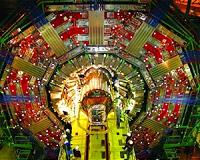 |
Durham NH (SPX) Apr 01, 2011 In a paper to be published in the April, 2011, issue of The Astrophysical Journal, scientists on NASA's Interstellar Boundary Explorer (IBEX) mission, including lead author Nathan Schwadron and others from the University of New Hampshire, isolate and resolve the mysterious "ribbon" of energy and particles the spacecraft discovered in the heliosphere - the huge bubble that surrounds our solar system and protects us from galactic cosmic rays. The finding, which overturns 40 years of theory, provides insight into the fundamental structure of the heliosphere, which in turn helps scientists understand similar structures or "astrospheres" that surround other star systems throughout the cosmos. The ribbon of energy was captured using ultra-high sensitive cameras that image energetic neutral atoms (instead of photons of light) to create maps of the boundary region between our solar system and the rest of our galaxy. Notes Schwadron, an associate professor at UNH's Institute for the Study of Earth, Oceans, and Space and department of physics, "Isolating and separating the ribbon from the IBEX maps was like pulling the drapes from our window to discover the landscape at the edge of the solar system." Of the singular images the IBEX mission has been able to achieve, lead scientist David McComas of the Southwest Research Institute (SwRI) says, "These maps are very rich scientifically and are critical in helping scientists understand how our space environment is controlled by the galactic medium. They provide the first images of our solar system's boundaries, which control the access to potentially harmful galactic cosmic rays as well as all other matter from deep space." The most energetic galactic cosmic rays penetrate even the powerful magnetic fields closest to Earth and eventually collide and interact with Earth's atmosphere. The direct or indirect effects of these cosmic rays on the Earth system, including our biosphere, remain poorly understood and are often highly controversial. The IBEX team is using the maps to learn how the heliosphere is shaped and what its physical properties are. This detailed information about our solar system's boundaries will allow scientists to better understand how galactic cosmic rays evolve in our space environment, which in turn will provide fundamental information about the radiation environment on Earth and its implications on the evolution of life. The IBEX scientists analyzed data from the mission's first year of observations and, after developing an effective separation method, were able to isolate and resolve the unanticipated energetic ribbon feature. The ribbon appears to be wrapped like a belt on top of the globally distributed emissions of the broader sky, and by separating it from the background emissions scientists can now see what's underneath the ribbon. Says Schwadron, "There are many theories about how the ribbon is created, and we don't understand exactly what we're seeing but it seems to be telling us something about how the local galactic magnetic field interacts with the heliosphere." Additional evidence for that interaction was the discovery of a "tail" of emissions in the underlying boundary landscape, which is apparently deflected in the direction of the galactic magnetic field as the ribbon seems to indicate. "This galactic magnetic field may be a missing key to understanding how the heliosphere protects the solar system from galactic cosmic rays," says Schwadron. Also seen in the maps is the expected feature of the "nose" of the heliosphere. The nose represents the direction in which the solar system moves through the local part of the galaxy nearest to our Sun and that Schwadron compares to the "bow wave in front of a ship, which shows us how our motion through the galaxy compresses and deflects the material of the local galactic medium around our heliosphere." The IBEX maps differ so radically from what was expected prior to the mission that the scientists have been struggling to untangle the vast amount of information the maps contain. The team notes that getting emissions from the nose of the heliosphere has been an important "lamp post" towards understanding how the global heliosphere is controlled by the interaction of the Sun with the local galactic medium. Says McComas, "Prior to IBEX, most scientists believed that the global boundaries of our solar system were controlled mainly by the motion of our solar system through the galaxy and the solar wind, an extremely fast flow of electrically charged matter that flows out from the Sun. The IBEX maps reveal the galactic magnetic field is also a critical part of the Sun's interaction with the galaxy." The mission launched October 19, 2008 and carries two ultra-high sensitivity cameras containing important components designed and built at UNH. In addition, the mission's Science Operations Center is headquartered at UNH.
Share This Article With Planet Earth
Related Links Interstellar Boundary Explorer (IBEX) mission Understanding Time and Space
 Rare Particles Produced At The Large Hadron Collider At CERN Observed
Rare Particles Produced At The Large Hadron Collider At CERN ObservedSyracuse, NY (SPX) Mar 29, 2011 Shortly after experiments on the Large Hadron Collider (LHC) at the CERN laboratory near Geneva, Switzerland began yielding scientific data last fall, a group of scientists led by a Syracuse University physicist became the first to observe the decays of a rare particle that was present right after the Big Bang. By studying this particle, scientists hope to solve the mystery of why the universe e ... read more |
|
| The content herein, unless otherwise known to be public domain, are Copyright 1995-2010 - SpaceDaily. AFP and UPI Wire Stories are copyright Agence France-Presse and United Press International. ESA Portal Reports are copyright European Space Agency. All NASA sourced material is public domain. Additional copyrights may apply in whole or part to other bona fide parties. Advertising does not imply endorsement,agreement or approval of any opinions, statements or information provided by SpaceDaily on any Web page published or hosted by SpaceDaily. Privacy Statement |